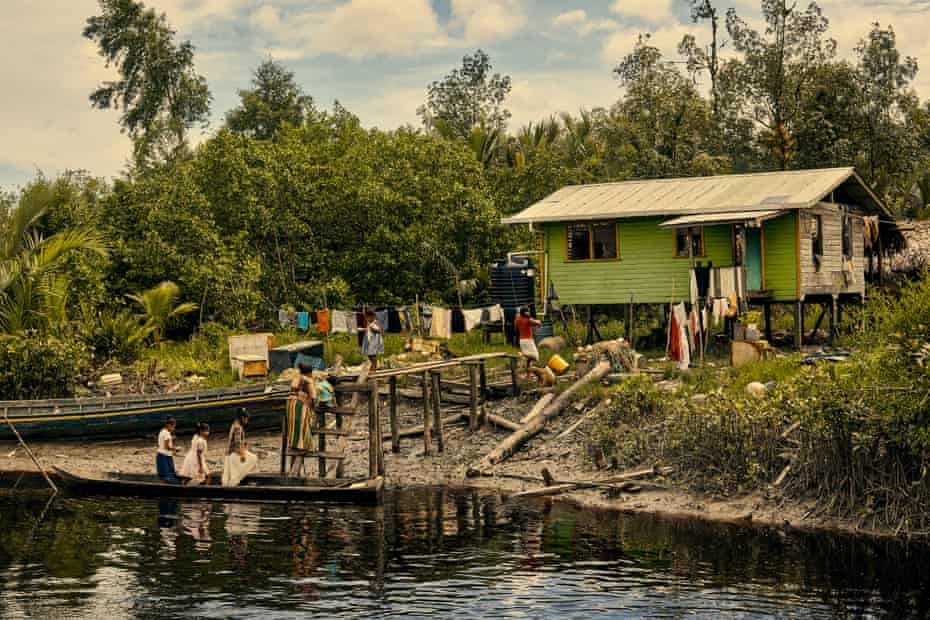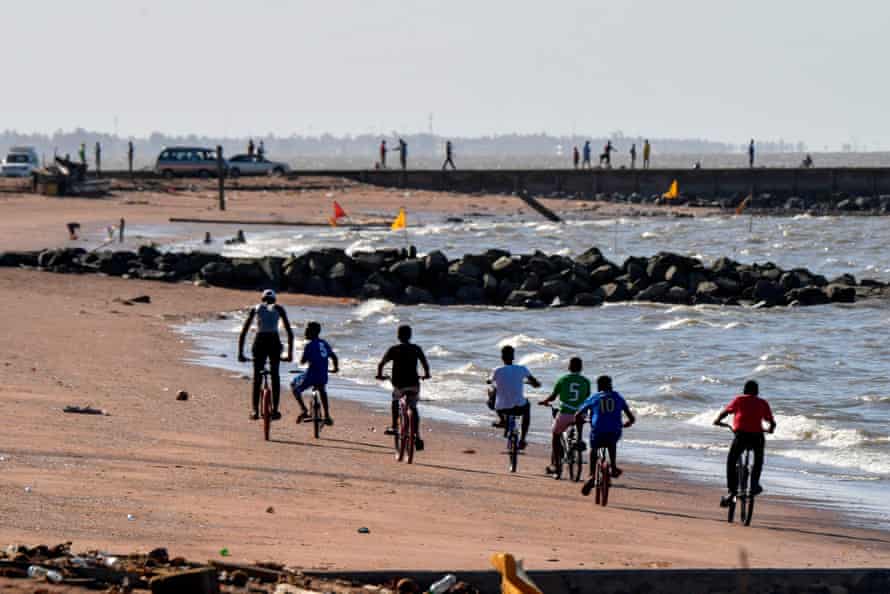Experts warn of potential for disaster as Exxon pursues 9bn barrels in sensitive marine ecosystem

Last modified on Tue 17 Aug 2021 19.50 BST
ExxonMobil’s huge new Guyana project faces charges of a disregard for safety from experts who claim the company has failed to adequately prepare for possible disaster, the Guardian and Floodlight have found.
Exxon has been extracting oil from Liza 1, an ultra-deepwater drilling operation, since 2019 – part of an expansive project spanning more than 6m acres off the coast of Guyana that includes 17 additional prospects in the exploration and preparatory phases.
By 2025, the company expects to produce 800,000 barrels of oil a day, surpassing estimates for its entire oil and natural gas production in the south-western US Permian basin by 100,000 barrels that year. Guyana would then represent Exxon’s largest single source of fossil fuel production anywhere in the world.
But experts claim that Exxon in Guyana appears to be taking advantage of an unprepared government in one of the lowest-income nations in South America, allowing the company to skirt necessary oversight. Worse, they also believe the company’s safety plans are inadequate and dangerous.
A top engineer who studies oil industry disasters, as well as a former government regulator, have leveled criticisms at Exxon. They say workers’ lives, public health and Guyana’s oceans and fisheries – which locals rely on heavily– are all at stake.

“Exxon is only going to be here for 20 to 25 years,” said Vincent Adams, Guyana’s former environment chief. “When they make all their billions, and they’re ready to pack up and they’re gone, we’ve got to deal with the mess.”
Environmental campaigners and activist shareholders suggest Exxon also cannot reconcile the project with its public commitments to address climate change and reduce carbon emissions.
Exxon claims its climate goals are “some of the most aggressive” in the industry, but its operations in Guyana will send more than 2bn metric tons of climate-destroying CO2 into the atmosphere.
Exxon contends that the company complies with all applicable laws in Guyana and adhered to a rigorous process to obtain environment authorization for its projects there. “Our work and the support of the government of Guyana are the basis of a long-term mutually-beneficial relationship that has already created significant value for the people of Guyana,” Exxon said in a written statement in response to questions from the Guardian.
Exxon’s ‘cash cow’
Robert Bea, among the world’s foremost forensic engineers and a leading expert on the 2010 BP oil spill in the Gulf of Mexico, worries that Exxon’s operations appear to lack the appropriate preparation or planning to head off a deepwater blowout and major oil spill. “I am far from comfortable,” Bea, co-director of the Marine Technology and Management Group Center for Risk Mitigation, said. “They should be too.”
Vincent Adams suggests Exxon is cutting corners to increase profits. Exxon “has no respect for the people’s health, safety and environment”, he said. Adams, a petroleum and environmental engineer, worked for 30 years at the US Department of Energy before returning to his native Guyana in 2018 to become executive director of the Environmental Protection Agency. He was let go in August 2020 when a new government came to power, and as his agency was trying to negotiate a stringent permit with Exxon.
Before Exxon’s operations, Guyana had no meaningful fossil fuels production, a point of pride for Melinda Janki, a Guyanese international environmental lawyer who is suing Guyana’s government to strip Exxon of its leases on climate and human rights grounds. She noted that rich rainforests cover 80% of Guyana, making it a carbon sink that absorbs far more of the planet-heating greenhouse gas than it emits. In 2015, Guyana made a commitment under the Paris climate accord to eliminate any reliance on fossil fuels.
But those achievements are now being undermined by Exxon, she said. The result of Exxon’s Guyana operations – from drilling the oil to burning it in cars – would be the release of 125m metric tons of carbon dioxide per year from 2025 to 2040. That’s roughly the equivalent of 15 large coal-fired power plants, according to Mark Chernaik, staff scientist at the Environmental Law Alliance Worldwide.
Moreover, Exxon flares, or burns, its excess gas. In the first 15 months of production alone, that flaring contributed nearly 770,000 metric tons of greenhouse gas emissions – the equivalent of driving 167,000 cars for one year.
In 2015, Exxon became the first company to strike a significant oil find in Guyana. It then swiftly pushed through a contract roundly criticised as one-sided in its favor. Exxon’s oil finds kept coming. It now estimates there are 9bn barrels of oil off the coast of Guyana. The Liza 1 prospect is the first to start pumping, with Exxon operating in deeper waters and nearly three times farther from shore than BP’s Deepwater Horizon rig in the Gulf of Mexico.
Exxon’s interest in Guyana is straightforward, according to Palzor Shenga, vice-president of analysis at Rystad Energy. The costs per barrel of oil produced in Guyana are a full $5 to $10 cheaper than the global average, making it, in Shenga’s words, a “cash cow”. This helps explain why Exxon began producing oil approximately twice as fast as “the industry average for projects of this size”, as Exxon boasted in its 2020 annual report.
Exxon told the Guardian that the “record pace” at which it is bringing projects online yields cost savings, which benefit Guyana. Critics say Exxon’s contract terms are lopsided. The government is receiving a below average return on Exxon’s projects, according to industry analysts at IHS Markit. Exxon receives more than 85% of the proceeds, the result of the government and public largely “absorbing Exxon’s costs”, according to the Institute for Energy Economics and Financial Analysis (IEEFA).
Exxon said that it will continue to “generate billions of dollars of revenue” for Guyana. Yet Guyana’s government has reported it has made just $309m from the projects since they began, while ExxonMobil and its partners had brought in roughly $1.8bn, said Tom Sanzillo, IEEFA director of financial analysis.

Former EPA chief Adams says Exxon exercises undue influence over government officials, who are far too often intimidated by the company. He cites, as one example, Exxon’s consistent flaring of gas, despite assurances to the government that it would not.
According to Exxon, the flaring is the result of a faulty gas compressor it has been unable to repair for more than a year and a half.
Janki recounted watching with horror a massive fire in the Gulf of Mexico last month, when a gas pipeline at a Pemex offshore oil platform set the ocean ablaze with what looked like waves of molten lava.
“What is really terrifying,” said Janki, is if Exxon’s failures are symptoms of a rushed job and potentially systemic problems that could have catastrophic ends.
The spectre of Macondo
The greatest anxiety is over the risk of an event like the Macondo – the BP well that blew out in 2010, resulting in the deaths of 11 men aboard the Deepwater Horizon rig and the world’s largest offshore drilling oil spill.
In 2017, Exxon submitted a 500-page environmental impact statement on Liza 1 to Guyana’s Environmental Protection Agency, stating: “Unplanned events, such as a large oil spill, are considered unlikely to occur because of the extensive preventative measures employed.”
Petroleum engineer Robert Bea said it was reminiscent of BP’s original plans for the Macondo well, which stated, it is “unlikely that an accidental surface or subsurface oil spill would occur from the proposed activities”. Asked if such contentions are “typical” in offshore drilling, he said: “absolutely not”. Rather, he says, they reveal “ignorance of risk management fundamentals”.
Bea worked for Shell Oil before becoming one of the world’s premier safety and disaster investigators. He served as a principal investigator on the BP Deepwater Horizon disaster, the Piper Alpha offshore oil disaster that killed 167 men in the North Sea, the Exxon Valdez grounding and the crash of the Nasa Columbia space shuttle.
Bea reviewed more than 1,000 pages of Exxon submissions and government permits for Liza 1, to conduct an exclusive analysis for this reporting, and concluded that: “We could have a problem similar to what we had with BP before and after the Macondo disaster.”
He said he found no evidence of the necessary planning and operations needed to “assess and manage the risks associated with high risk offshore exploration, production, and transportation operations”. Exxon is instead offering superficial safety plans based on unsubstantiated claims of its capabilities in Guyana that fail to take account of the highly hazardous risks associated with its operations, he said.
There are “loose ends, assumptions, and premises that are not substantiated” in Exxon’s plans, Bea said. “And the more of these threads that you tug at, the more concerned you become that what’s being done here is superficial.”
In particular, Bea is worried about a loss of well control, or blowout – which could cause a catastrophic oil spill. He finds that Exxon has not kept the risks of such events as low as “reasonably practicable”, based on the documents he reviewed. Bea cites numerous problems with Exxon’s plans.
If a blowout occurs in Guyana, Exxon says it would be contained within 21 to 30 days –an estimate Bea said is far too optimistic, unsubstantiated and improbable.
He points in particular to the inadequate provision of the tools needed to stop a blowout and oil spill, namely a capping stack and relief well.
Similar concerns raised by Bea to officials in Australia resulted in the government there strengthening its requirements, which ultimately led BP to withdraw its plans to drill in the Australian Bight.
In addition Exxon’s plans for a potential oil spill response rely on methods that were heavily criticized when deployed in previous disasters. Exxon intends to use Corexit 9500, a chemical dispersant banned in the UK and faulted for severe human and environmental harms when used in the Exxon Valdez and BP oil spills. Exxon also intends to burn oil on the ocean surface even though it is drilling in the Amazon-Orinoco Influence Zone, an area rich in marine biodiversity, with rare and threatened species on which local Indigenous and other fishers depend.
Even with these measures, Exxon estimates a spill could send oil throughout the Caribbean Sea, across Trinidad and Venezuela, and as far as Jamaica. Exxon is relying on Guyana’s recently drafted national oil spill response plan; yet there remains a wide chasm between what’s written on paper and the government’s ability to implement it, argued former EPA chief Adams.
Adams said Guyana has insufficient equipment, personnel, expertise, funding and clear lines of responsibility to respond in a disaster. Adams also worries that the government will be forced to foot the bill if there is a disaster, because Exxon is placing liability for the project with a subsidiary.

“Guyana is wholly unprepared for a Macondo,” said Janki, who formerly served as in-house legal counsel for oil giant BP and drafted many of Guyana’s national environmental laws. The results of a blowout were catastrophic in the United States despite ample money, experience and infrastructure, she said, and “Guyana doesn’t have any of that.”
Exxon did not respond to the specific claims made by Bea, Adams and Janki, but said it has adhered to Guyanese laws and instituted “robust compliance assurance systems that enable identification and timely reporting of operational issues with the Environmental Protection Agency and Ministry of Natural Resources” of Guyana. Guyana’s government did not respond to requests for comment.
Adams said while Exxon would not deliberately cause an accident, “they’re going to bring it to the line [and take] the chance that nothing is going to happen until something happens. That’s what keeps me up at night.”
Investor woes
Exxon has come under public attack by its shareholders over its continued commitment to fossil fuels and inaction on climate. In May, shareholders voted in three new board members committed to diversifying Exxon’s operations and hitting meaningful targets to reduce its greenhouse gas emissions.
The investor advocacy group, As You Sow, criticized Exxon’s plans to open a massive new oil frontier in Guyana in the face of the International Energy Agency’s recent recommendations that there should be no investment in new fossil fuel supply. “Exxon’s activities in Guyana pose grave material risks to the company from an economic, legal, and human rights standpoint,” argued As You Sow CEO Andrew Behar. “We believe it’s fundamentally a flawed mission” that should be shut down.
Massive new oil production in Guyana raises other potential legal red flags for investors, warned Kathy Mulvey, the accountability campaign director of the Union of Concerned Scientists. She cited the court ruling in the Hague last month finding Shell liable for its contributions to climate change and said that other oil companies will also have to “reduce the worldwide oil and gas extraction.”
“We’re concerned that the people of Guyana are being asked to bet their economy and their future on oil when oil has no future in a carbon-constrained world,” said Carroll Muffett, president of the US Center for International Environmental Law.
In recent press statements, Exxon has reasserted its support of the Paris Agreement, yet failed to respond to these specific investor concerns, citing instead the significant economic development and job creation for Guyana that its operations provide there. Janki said she hopes more people will come to see what is at risk from Exxon’s operations in Guyana.
“We are facing a decision: our survival, or the survival of the fossil fuel sector,” Janki warned.

